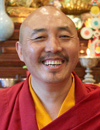
We are not attempting to change the nature of appearances from impure to pure. Appearances of themselves have always been pure.
We have always been Samantabhadra; we have always been White Tara. We’re not trying to become White Tara. We’re trying to recognize that we already are White Tara.
We are not whoever we think we are. We have a name; we have concepts; we have an identity — these are wrong; they’re fiction.
We come to see things as they are by cultivating the habit of seeing them as they are, which basically means removing the habit — the bad habit — that we have had since the moment appearances first arose from the ground and Samantabhadra recognized them for what they were and we did not, the bad habit that we have cultivated of mistaking things to be impure. So, we see things as they are not, because we have the habit of doing so. We need to replace that habit gradually.
A distinction has to be made. While the sutra and tantra approaches are equally the teachings of the Buddha, and ultimately have the same intention, a distinction needs to be made between the attitude toward appearances that is encouraged in the sutra, especially in the lesser vehicle, and the attitude toward appearances that is proscribed in tantra.
From the point of view of the vajrayana, our worst problem is self-denigration, the denigration of our aggregates, elements, and senses as impure. From the point of view of the sutras, in particular of the Vinaya and so forth — the common vehicle — these aggregates, elements, and sense are stated to be impure, troublesome, filthy, and so on. One attempts to cultivate disgust for them as a basis for the achievement of freedom. But in the vajrayana one does not cultivate disgust for the aggregates, elements, and senses. In fact, it is considered a violation of samaya every time you perceive earth as mere earth, or water as mere water, or fire as mere fire, or air as mere air. You keep samaya by recognizing water as Mamaki, fire Pandaravasini, earth as Buddhlochana, and wind or air as Samayatara.
So, the way that we approach appearances has to reflect our actual level in what we are practicing. If we are practicing vajrayana, then we need to confidently learn to regard and recollect the fact that all things are pure. All men and women are dakas and dakinis. The four elements themselves are female buddhas, and so forth.
[From a teaching on Essence of Wisdom: Stages of The Path, Part 3 by Lama Tashi Topgyal. Translated by Lama Yeshe Gyamtso. Full teaching available from the KPL bookstore as an MP3 download.]
